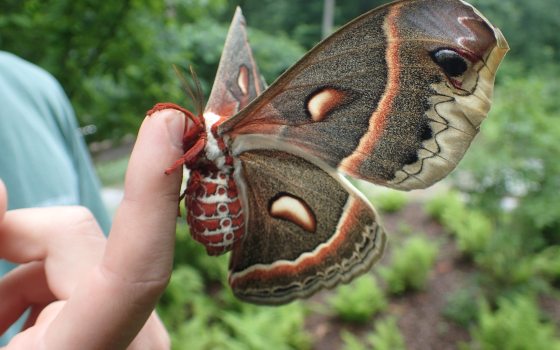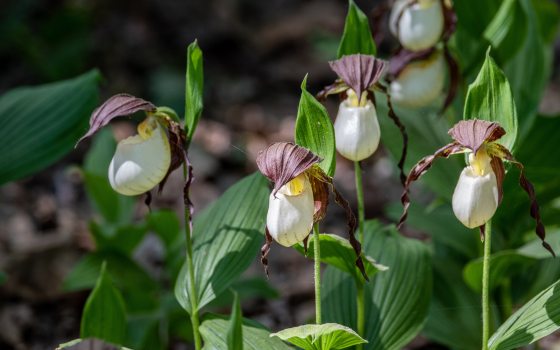This July, in the dark of the new moon, an unusual celebration will be taking place all over the United States. No, it’s not the Fourth of July—it’s National Moth Week! From July 22 through July 30, nature lovers and moth enthusiasts across the country will be celebrating these secretive, under-appreciated insects. While moths are often mischaracterized as the drab, irksome cousins of the butterfly, this could not be farther from the truth. In fact, moths are much more numerous and varied than butterflies—and in many cases, more colorful! It is thought that there are 10 to 15 times more species of moths than butterflies, with over 12,000 species native to the United States alone. Efforts to inventory the many hundreds of resident moth species here at Longwood Gardens are still ongoing.
As one of the largest and most successful groups of animals on the planet, moths are extraordinarily diverse, and employ fascinating survival strategies across all stages of their lives. Some use bright colors to distract and bewilder potential predators, while others will mimic leaves, bark, or even bees to hide in plain sight. As caterpillars (the larval stage of both moths and butterflies), moths can fly on silken parachutes, construct elaborate mobile homes, sting, or live underwater. To me, learning about the fascinating lives of these creatures was more than enough to spark my curiosity many years ago when I took up moth-watching (or “mothing”) as a hobby. But even if moths aren’t your cup of tea, it’s hard to understate their ecological importance and the impact that they have on the world around us.
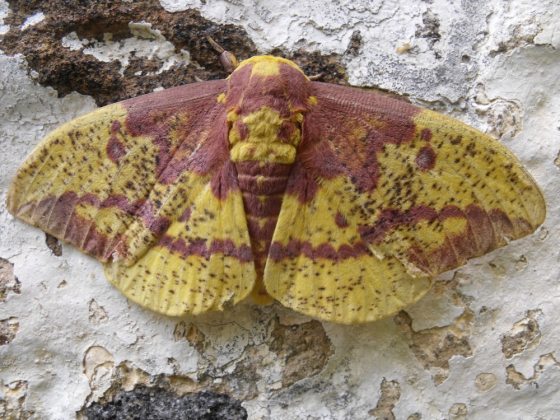
What Makes a Moth?
Moths have been an important part of Earth’s biosphere since the time of the dinosaurs, predating the appearance of butterflies by many millions of years. The earliest surviving fossils of moths are more than 190 million years old, roughly coinciding with the first appearance of flowering plants. Given that many moths fly at night and ignore flowers altogether, it is possible that they may be even older. In fact, most moths don’t feed at all as adults, and rely entirely on stored food from the caterpillar stage. Moth caterpillars feed on a wide variety of plants, and like butterflies, usually require a specific species of host plant to survive. Indeed, the extraordinary diversity and abundance of moth species (between 150,000 to 500,000 worldwide!) is a direct result of their long history and specialized diets. Contrary to popular belief, most moths do not have any interest in eating your clothes. In Pennsylvania, only the caterpillars of two species—the webbing clothes moth and the case bearing clothes moth—are able to consume fabric.
So, if most moths aren’t the dull, drab, dresser-feeders that they are made out to be, what are they really? Like all other insects, adult moths possess an exoskeleton, three pairs of legs, a three-part body (head, thorax, and abdomen), compound eyes, and a pair of antennae. As members of the Lepidopteran order—which they share with butterflies and skippers—moths progress (or metamorphose) through four life stages: egg, caterpillar, pupa, and adult. While it is difficult to tell butterflies apart from moths during these first three stages, they can easily be identified by their antennae in the adult stage. While almost all butterflies and skippers possess “club-like” antennae, moth antennae are almost always feathered or threadlike.
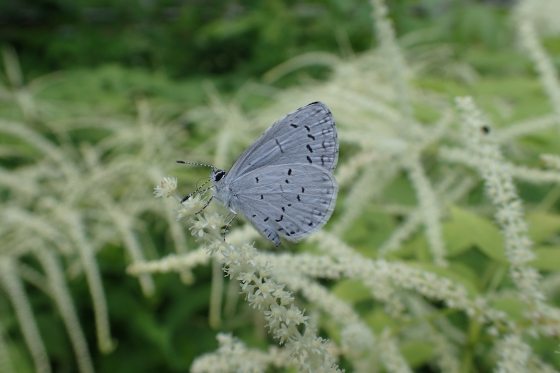
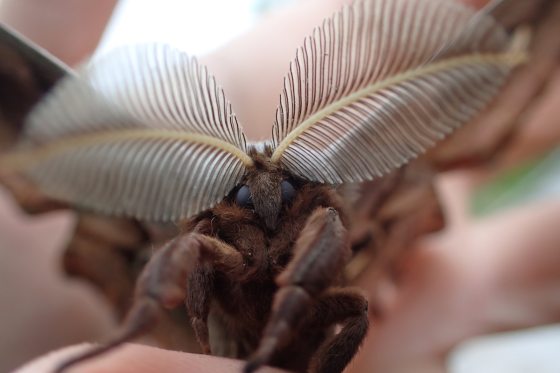
As most moths are nocturnal, they rely on these highly developed antennae to find each other in the dark through the use of pheromones—complex chemical scents that they can detect many miles away. The males of some species, such as the Indian moon moth, can successfully locate a female from up to 11 km away, and can smell even a single molecule of pheromone. In general, male moths tend to have larger, showier antennae that are specially adapted for this purpose. Most moths can also be identified by their stout, fuzzy bodies (better for flying in the cool of night), and their fatal attraction to bright lights. While this behavior is not yet fully understood, it is clear that the level of attraction depends on the strength and wavelength of the light in question as well as the species of moth involved.
Cocoons and Silk
Another way to easily distinguish moths from butterflies is by their silken cocoons. Although not all species of moths are able to produce silk, many species use it to protect themselves during their vulnerable pupal stage. Members of the Saturniidae or giant silk moth family have become famous as the sole providers of commercial silk—including the Chinese silkworm, the world’s only domesticated insect. While this particular species is not native to North America, and has been the subject of many ill-fated attempts to create a domestic silk industry in the United States (instead giving us the gypsy moth, white mulberry, and tree-of-heaven, among other things), many Americans are better acquainted with our magnificent native silk moths. These wild, undomesticated moths are exceptionally large and strikingly colored. Some, like the spectacular Cecropia or “robin moth,” can have a wingspan of more than six inches, making them the largest moths in North America.
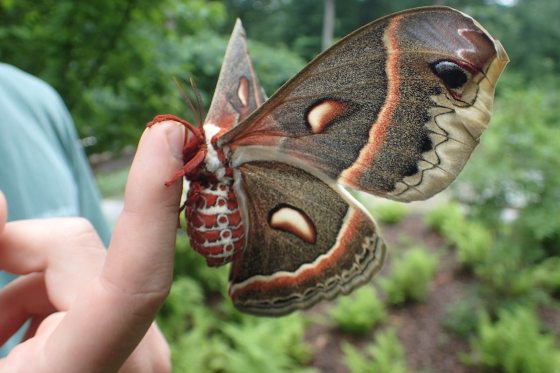
Though common, this particular species is seldom seen due to its short lifespan (a few days at most) and the fact that they only fly in the earliest hours of the morning on warm, summer nights. Like all giant silk moths, Cecropias don’t feed as adults, and rely exclusively on stored energy from their caterpillar stage. Night-flying birds like the Eastern whip-poor-will find them especially tasty for this reason, and time their egg-laying so that their hungry chicks will hatch just before the full moons of summer, when their quarry is most visible and active.
Unfortunately, the Cecropia—like many of our native silk moth species—is currently experiencing a dramatic decline in population throughout the northeastern United States due to light pollution, habitat loss, and the introduction of non-native parasites for gypsy moth control. If you want to help these beautiful creatures, I would recommend doing the following:
- Turn off bright exterior lights at night, or switch to insect-friendly LEDs
- Relocate your fallen leaves (which may hide overwintering cocoons) instead of burning or shredding them
- Carefully inspect your shrubs for cocoons before trimming them in the fall
At Longwood, we make sure to check for overwintering silkmoth cocoons in our natural areas before they are burned or mowed each spring. The cocoons are then safely relocated and overwintered in squirrel-proof cages, and the adult moths are released as they emerge later in the summer.
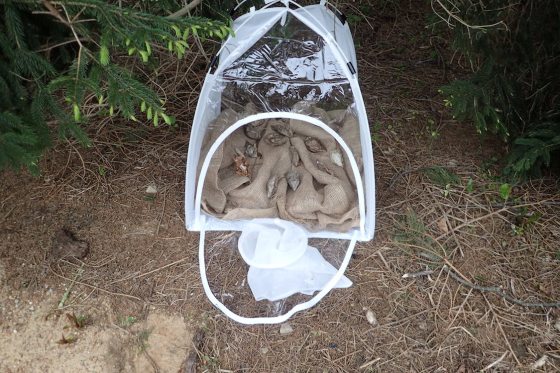
Masters of Disguise
It is likely that the same factors that are causing silk moth declines in the Northeast are also devastating other moth families as well. However, while silk moths are large and showy, most moths are veritable masters of disguise, making their populations extremely hard to track. For many common species, basic information on population size, range, and even life history is still unknown. Indeed, the “drab” reputation of moths testifies to how successful they are at avoiding notice and staying out of trouble. Many night-flying moths resemble bark, leaves, or other natural materials to help them blend in during the day.
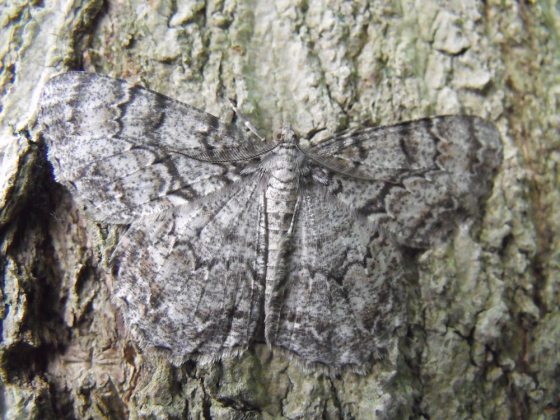
Some, like the rosy maple moth, will even mimic parts of their caterpillar host plant—in this case, the pink and yellow fruit of the maple tree. But while camouflage can be an effective strategy for night-flying moths, the day-fliers don’t have the luxury of holding still. Because of their more active, conspicuous lifestyles, day-flying moths often resort to mimicking other insect and animal species—particularly those that predators will avoid. In fact, many of the bees and wasps that you see visiting flowers during the day are actually harmless moths! While their elaborate disguises deny them any credit for their work, these day-flying moth species are still important pollinators of many flowers and crops.
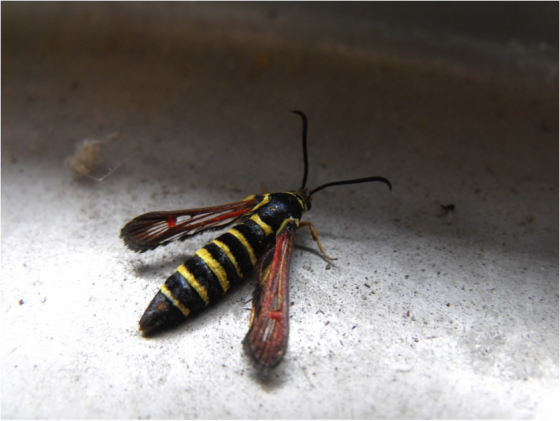
While stinging insects are always a safe choice to mimic, some moth species will go to great lengths to mimic snakes, spiders, or even bird droppings in their quest for safety. Famously, the hummingbird clearwing moth does an excellent job at mimicking the ruby-throated hummingbird right down to the tail feathers.
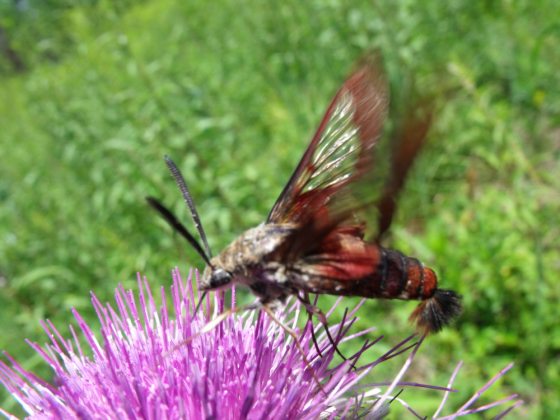
On the Defense!
Other moths, however, take a more active role in predator defense. Like butterflies, many moths use poisons and noxious chemicals derived from the host plants that they feed on as caterpillars. Most of these species are plant specialists, and are perfectly adapted to consume, detoxify, and reappropriate plant chemical defenses for their own use. One such species is the milkweed tussock moth, which can be seen devouring common milkweed throughout the Meadow Garden. Just like the monarch butterfly, these moths are very distasteful (and sometimes poisonous) to birds and other day-time predators. At night, when their warning colors cannot be seen by nocturnal predators, many species of tiger moths will actually advertise their poisonous nature by sending out sonar clicks as a warning to bats.
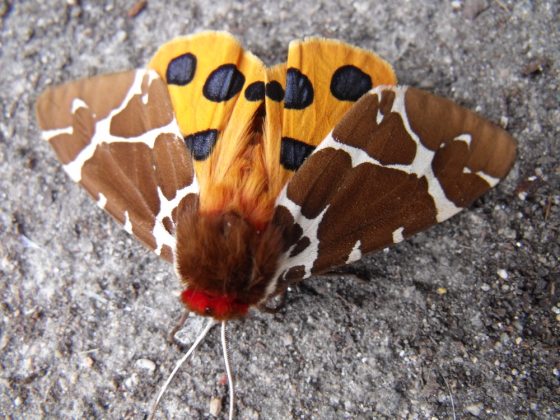
Some non-poisonous species, like Grote’s bertholdia (a southwestern tiger moth), are even capable of jamming bat sonar altogether by bombarding them with loud clicks. Luna moths, on the other hand, attempt to dampen bat sonar signals by thick fur and long tails—making them the stealth-fighters of the insect world.
Caterpillars
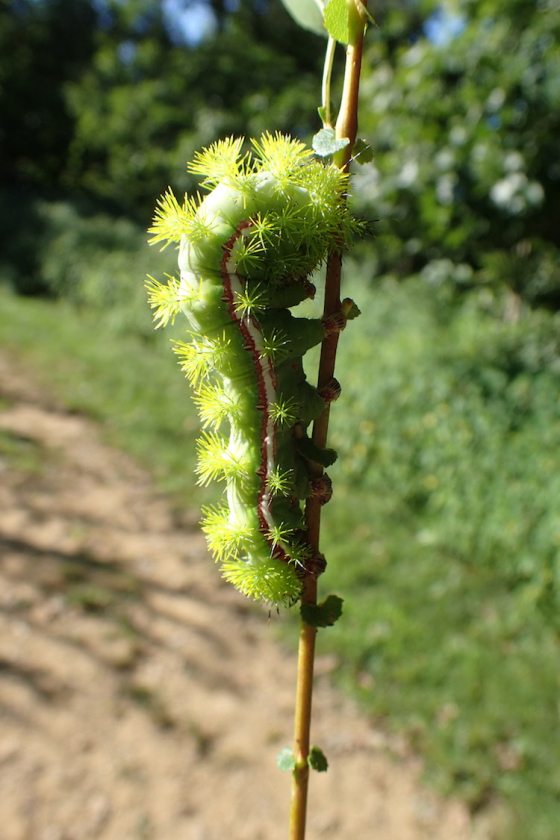
In fact, most colorful, “fuzzy” caterpillars in our area are capable of stinging, and I would strongly advise against touching any of them without closer identification. There are, of course, exceptions to this, as fuzz can serve other purposes besides defense. Many moths use this fuzz to keep warm through cool nights or cold winters. The beloved woolly bear, the harmless caterpillar stage of the Isabella tiger moth, is particularity skilled at this. While most moths overwinter in protective silken cocoons or even deep underground, the woolly bear—like most tiger moths—will overwinter as caterpillars.
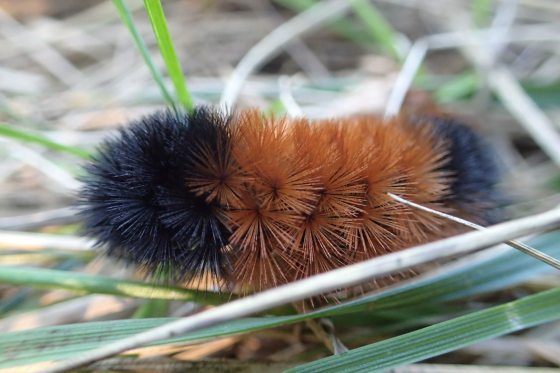
In the fall, you can see many of them crossing roads and other obstacles in search of a good hiding place. Once secure under a warm pile of leaves or fallen timber, their thick fur and natural antifreeze help them survive until spring, when they resume feeding and continue their life cycle. In some areas of the Arctic where the growing season is short, woolly bears will spend up to 14 years as a caterpillar before they get enough food to pupate! Other moth species can go through many generations in a single summer, or spend years underground before emerging.
Keystone Species
A moth’s life (and death), when it comes down to it, is really all about food. As caterpillars, they feast continuously on the leaves of their chosen host plant, stopping only to find shelter from predators or to move to the next leaf. While their voracious appetites have given them a well-deserved reputation as agricultural pests, most species of moths have little interest in our crops and gardens. By trying to rid ourselves of these “pests,” we are actually doing a grave disservice to the things that eat them. At all life stages, moths serve as a critical food source for many of the birds and other animals that we know and love. In fact, current research has shown that moth caterpillars are the preferred “baby food” of nestling birds, as they are both easy to digest and full of protein. Over 98% of our native birds—including hummingbirds, bluebirds, and swallows—feed their young exclusively with insects. During the spring, the Eastern tent caterpillar is an especially important food source for many birds and other animals in our area.
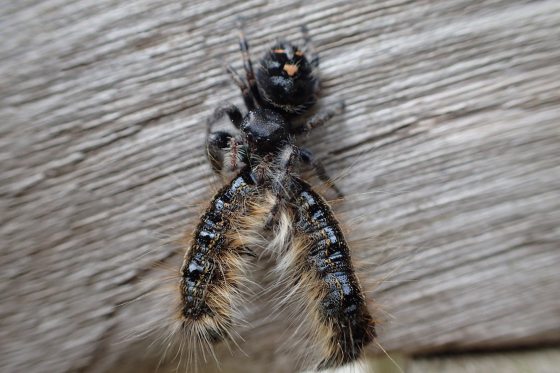
These moth caterpillars, while often confused with the invasive gypsy moth (which don’t spin webs), may spin unsightly webs but are not in fact damaging to the trees they defoliate. One of the main reasons why gypsy moths are able to decimate our oak forests is that their populations cannot be kept in check by local birds, which cannot eat them due to their irritating hairs.
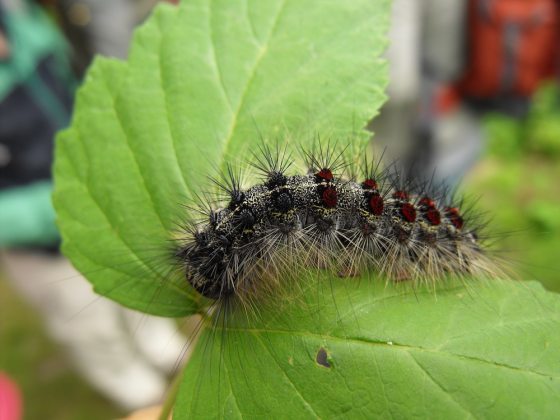
When native moth species like the Eastern tent caterpillar and the fall webworm experience similar population booms, it is usually the birds that benefit most. If you want to help birds and get rid of tent caterpillars, simply speed this process along and break open the nests that these communal feeders rely on for protection. Similarly, a landscape devoid of moths and their caterpillars is ecologically impoverished. Declines in silk moth populations have been linked to the decline of Eastern whip-poor-wills and other night-flying insectivorous birds, which time their brooding for full moons and silk-moth emergence. Personally, as a self-described “moth-er,” I think that the amazing lives of these creatures give them an inherent right to exist. But in the big picture, it is hard to ignore the ecological importance of moths and the important role that they play in the world around us. So the next time you are out at night this summer, take some time and check out a bright light near you and marvel at what’s flown in.
Photos by Colin McCallum-Cook.
